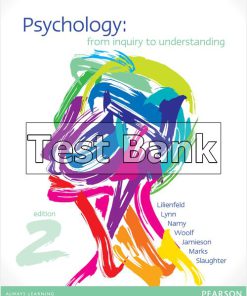$26.50$50.00 (-47%)
In stock
Psychology A Framework for Everyday Thinking 1st Edition Lilienfeld Test Bank.
You may also like
This is completed downloadable of Psychology A Framework for Everyday Thinking 1st Edition Lilienfeld Test Bank

Product Details:
- ISBN-10 : 9780205650484
- ISBN-13 : 978-0205650484
- Author: Scott O. Lilienfeld (Author), Steven J. Lynn (Author), Laura L. Namy (Author), Nancy J. Woolf (Author)
Psychology: A Framework for Everyday Thinking provides an accessible and personalized framework that students need to go from understanding to the application of the science of Psychology.
This brief edition text (14 chapters) teaches students how to critically evaluate psychological claims that they experience in everyday life and to apply the science of psychology to the world around them.
Table of Content:
| Chapter 1: Psychology and Scientific Thinking |
| Chapter 2: Research Methods |
| Chapter 3: Biological Psychology |
| Chapter 4: Sensation and Perception |
| Chapter 5: Learning |
| Chapter 6: Memory |
| Chapter 7: Language, Thinking and Intelligence |
| Chapter 8: Human Development |
| Chapter 9: Emotion and Motivation |
| Chapter 10: Stress, Health, and Bodily Rhythms |
| Chapter 11: Social Psychology |
| Chapter 12: Personality |
| Chapter 13: Psychological Disorders |
| Chapter 14: Psychological and Biological Treatments |
Full Table of Contents:
Ch. 1: Psychology and Scientific Thinking
What is Psychology? Common versus Uncommon Sense
Psychology and Levels of Explanation
Psychology: A Nasty Little Subject
Naïve Realism: Seeing is Believing, Or Is It?
When Our Common Sense is Right
The Amazing Growth of Popular Psychology
Psychology as a Science
Critical Thinking: Sorting the Wheat from the Chaff
Scientific Skepticism
Basic Principles of Critical Thinking
Psychological Pseudoscience: Imposters of Science
What is Pseudoscience?
Metaphysical Claims: The Boundaries of Science
Warning Signs of Pseudoscience
Why Are We Drawn to Pseudoscience?
The Dangers of Pseudoscience: Why Should We Care?
Psychology’s Past and Present: What a Long, Strange Trip It’s Been
The Great Theoretical Frameworks of Psychology
The Multifaceted World of Modern Psychology
The Great Debates of Psychology
What Makes Psychology Challenging—and Fascinating
Ch. 2: Research Methods
The Beauty and Necessity of Good Research Design
Why We Need Research Designs
Heuristics and Biases: How We Can Be Fooled
The Scientific Method: Toolbox of Skills
Naturalistic Observation: Studying Humans “In the Wild”
Case Study Designs: Getting to Know You
Correlational Designs
Experimental Designs
Asking People about Themselves and Others
Ethical Issues in Research Design
Ethical Guidelines for Human Research
Ethical Issues in Animal Research
Statistics: The Currency of Psychological Research
Descriptive Statistics: What’s What?
Dispersion: How the Data Scatter
Inferential Statistics: Testing Hypotheses
How People Lie with Statistics
Becoming a Peer Reviewer of Psychological Research
Trying Your Hand at Peer Review
Most Reporters Aren’t Scientists: Evaluating Psychology in the Media
Ch. 3: Biological Psychology
Nerve Cells: Communication Portals
Neurons: The Brain’s Communicators
Glial Cells: Supporting Roles
Chemical Communication: Neurotransmission
Electrifying Thought
Neural Plasticity: How and When the Brain Changes
Neural Plasticity Following Injury and Degeneration
The Brain–Behavior Network
CNS: The Command Center
The Limbic System
The Brain Stem
The Cerebral Ventricles
The Somatic Nervous System
The Autonomic Nervous System
The Endocrine System
Mapping the Mind: The Brain in Action
A Tour of Brain-Mapping Methods
How Much of Our Brain Do We Use?
Which Parts of Our Brain Do We Use for What?
Which Side of Our Brain Do We Use for What?
Nature and Nurture: Did Your Genes—Or Parents—Make You Do It?
How We Came to Be Who We Are
Behavioral Genetics: How We Study Heritability
Ch. 4: Sensation and Perception
Two Sides of the Coin: Sensation and Perception
Sensation: Our Senses as Detectives
Perception: When Our Senses Meet Our Minds
Subliminal Information Processing
Extrasensory Perception (ESP): Fact or Fiction?
Seeing: The Visual System
Light: The Energy of Life
The Eye: How We Represent the Visual Realm
Visual Perception
Hearing: The Auditory System
Sound: Mechanical Vibration
How the Ear Works
Auditory Perception
Smell, Taste, and Touch: The Sensual Senses
Taste and Smell Go Hand-in-Hand
Olfactory and Gustatory Perception
The Somatosensory System: Touch and Pain
Proprioception and Vestibular Sense: Body Position and Balance
Alterations in Sensation and Perception
Hallucinations: Experiencing What Isn’t There
Out-of-Body Experiences
Near-Death Experiences
Déjà Vu Experiences
Hypnosis
Ch. 5: Learning
Classical Conditioning
Pavlov’s Discoveries
The Classical Conditioning Phenomenon
Aversive Conditioning
Adaptive Value of Classical Conditioning
Acquisition, Extinction, and Spontaneous Recovery
Stimulus Generalization and Discrimination
Higher-Order Conditioning
Applications of Classical Conditioning to Daily Life
Operant Conditioning
Operant Conditioning: What It Is and How It Differs from Classical Conditioning
The Law of Effect
B.F. Skinner and Reinforcement
Terminology of Operant Conditioning
Principles of Reinforcement
Applications of Operant Conditioning
Two-Process Theory: Putting Classical and Operant Conditioning Together
Cognitive Models of Learning
Watson, Skinner, and Thinking
S-O-R Psychology: Throwing Thinking Back into the Mix
Latent Learning
Observational Learning
Biological Influences on Learning
Conditioned Taste Aversions
Preparedness and Phobias
Instinctive Drift
Learning Fads: Do They Work?
Sleep-Assisted Learning
Discovery Learning
Learning Styles
Ch. 6: Memory
How Memory Operates: The Memory Assembly Line
The Paradox of Memory
The Fallibility of Memory
The Reconstructive Nature of Memory
The Three Systems of Memory
Differences Between Long-Term and Short-Term Memory
Primacy and Recency Effects: Forgetting Isn’t Random
Types of Long-Term Memory: Different Flavors or Different Meals?
The Three Stages of Remembering
Encoding: The “Call Numbers” of the Mind
Storage: Filing our Memories Away
Retrieval: Heading for the “Stacks”
The Biology of Memory
The Neural Basis of Memory Storage
Where Is Memory Stored?
The Biology of Memory Deterioration
The Development of Memory: Acquiring a Personal History
Memory over Time
Infants’ Implicit Memory: Talking with Their Feet
Infantile Amnesia
Suggestibility and Child Testimony
When Good Memory Goes Bad: False Memories
False Memories
The Seven Sins of Memory
Ch. 7: Language, Thinking, and Intelligence
How Does Language Work?
The Features of Language
How Do Children Learn Language?
Special Cases of Language Learning
Nonhuman Animal Communication
Do We Think in Words? The Relation between Language and Thought
Thinking and Reasoning
Cognitive Economy—Imposing Order on Our World
The Risks of Economizing: You Get What You Pay For
Problem Solving: More Thinking Hurdles
The Scientific Method Doesn’t Come Naturally
What Is Intelligence? Definitional Confusion
Definitions of Intelligence
The Rest of the Story: Other Dimensions of Intellect
Biological Bases of Intelligence
Intelligence Testing: The Good, the Bad, and the Ugly
Two More Controversial Letters: IQ
The Eugenics Movement: Misuses and Abuses of IQ Testing
IQ Testing Today
Reliability of IQ Scores: Is IQ Forever?
Validity of IQ Scores: Predicting Life Outcomes
A Tale of Two Tails: From Mental Retardation to Genius
Genius and Exceptional Intelligence
Individual and Group Differences in IQ
Exploring Genetic and Environmental Influences on IQ
Poverty and IQ: Socioeconomic and Nutritional Deprivation
Getting Smarter All the Time: The Mysterious Flynn Effect
Group Differences in IQ: The Science and the Politics
Ch. 8: Human Development
Special Considerations in Human Development
Bidirectional Influences
Keeping an Eye on Cohort Effects
The Influence of Early Experience
Distinguishing Nature from Nurture
The Developing Body before and after Birth: Physical and Motor Development
Conception and Prenatal Development: From Zygote to Baby
Infant Motor Development: How Babies Get Going
Cognitive Development: Children’s Learning about the World
Piaget: How Children Construct Their Worlds
Vygotsky: Social and Cultural Influences on Learning
Contemporary Theories of Cognitive Development
Social and Moral Development: Children’s Relations with Others
Stranger Anxiety: The Sudden Change at 8 Months
Attachment: Establishing Bonds
Temperament and Social Development: Our Emotional Endowment
Gender Identity
Development Doesn’t Stop: Changes in Adolescence and Adulthood
Adolescence: A Time of Dramatic Change
The Ups and Downs of Adulthood
Who Is Old? Differing Concepts of Old Age
Ch. 9: Emotion and Motivation
Theories of Emotion: What Causes Our Feelings?
Discrete Emotions Theory: Emotions as Evolved Expressions
Cognitive Theories of Emotion: Think First, Feel Later
Unconscious Influences on Emotion
Emotional Expression through Body Language
Happiness and Self-Esteem: Science Confronts Pop Psychology
Positive Psychology: Psychology’s Future or Psychology’s Fad?
What Happiness Is Good For
What Makes Us Happy: The Myths
What Makes Us Happy: The Realities
Forecasting Happiness
Self-Esteem: Important or Overhyped?
Motivation: Our Wants and Needs
Motivation: A Beginner’s Guide
Positive Motivation
Our Needs: Physical and Psychological Urges
Hunger, Eating, and Eating Disorders
Sexual Motivation
Attraction, Love, and Hate: The Greatest Mysteries of Them All
Social Influences on Interpersonal Attraction
Love: Science Confronts the Mysterious
Hate: A Neglected Topic
Ch. 10: Stress, Health, and Bodily Rhythms
What Is Stress?
Stress in the Eye of the Beholder: Three Approaches
No Two Stresses Are Created Equal: Measuring Stress
How We Adapt to Stress: Change and Challenge
The Diversity of Stress Responses
The Brain–Body Reaction to Stress
The Immune System
Stress-Related Illnesses: A Biopsychosocial View
Coping with Stress
Social Support
Gaining Control
Individual Differences in Coping: Attitudes, Beliefs, and Personality
Promoting Good Health—and Less Stress!
Drug Use and Abuse
Substance Abuse and Dependence
Types of Drugs
Changing Lifestyles Is Easier Said than Done
Strategies for Positive Change
Health Psychology and Behavioral Medicine
Alternative and Complementary Medicine
To Sleep, Perchance to Dream
The Circadian Rhythm: The Cycle of Everyday Life
Stages of Sleep and Dreaming
Theories and Psychology of Dreams
Neurocognitive Perspectives on Dreaming: Information Processing and Development
What’s the Function of Dreams?
Disorders of Sleep
Ch. 11: Social Psychology
What Is Social Psychology?
Humans as a Social Species
The Great Lesson of Social Psychology
Social Comparison: Person See, Person Do
Social Influence: Conformity and Obedience
Conformity: The Asch Paradigm
Deindividuation: Losing Our Typical Identities
Groupthink
Groupthink in the Real World
Treatments for Groupthink
Group Polarization: Going to Extremes
Cults and Brainwashing
Cults: Common Misconceptions
Obedience: The Psychology of Following Orders
Helping and Harming Others: Prosocial Behavior and Aggression
Safety in Numbers or Danger in Numbers? Bystander Nonintervention
Social Loafing: With a Little Too Much Help from My Friends
Prosocial Behavior and Altruism
Aggression: Why We Hurt Others
Attitudes and Persuasion: Changing Minds
Attitudes and Behavior
Origins of Attitudes
Cognitive Dissonance and Attitude Change
Persuasion: Humans as Salespeople
Prejudice and Discrimination
The Nature of Prejudice
Discrimination
Stereotypes
Stereotypes Behind the Scenes
Ultimate Attribution Error
Roots of Prejudice: A Tangled Web
Combating Prejudice: Some Remedies
Ch. 12: Personality
Personality: What Is It and How Can We Study It?
Researching the Causes of Personality: Overview of Twin and Adoption Studies
Reared-Together Twins: Genes or Environment?
Reared- Apart Twins: Shining a Spotlight on Genes
Adoption Studies: Further Separating Genes and Environment
Behavior-Genetic Studies: A Note of Caution
Psychoanalytic Theory: The Controversial Legacy of Sigmund Freud and His Followers
Core Assumptions of Psychoanalytic Theory
The Three Agencies of the Human Psyche
Anxiety and the Defense Mechanisms
Freud’s Theory of Personality Development
Psychoanalytic Theory Evaluated Critically
1) Unfalsifiability
2) Failed Predictions
3) Questionable Conception of the Unconscious
4) Reliance on Unrepresentative Samples
Summary
Freud’s Followers: The Neo-Freudians
Behavioral, Social Learning, and Humanistic Theories of Personality
Behavioral Views of the Causes of Personality
Social Learning Theories of Personality: The Causal Role of Thinking Resurrected
Humanistic Models of Personality: The Third Force
Rogers and Maslow: Self-Actualization Realized and Unrealized
Humanistic Models Evaluated Critically
Trait Models of Personality: Consistencies in Our Behavior
Trait Models: Key Challenges
Personality Traits Under Siege: Walter Mischel’s Critique
Models of Personality Structure: The Big Five
Cultural Influences on Personality
Trait Models Evaluated Critically
Personality Assessment: Measuring and Mismeasuring the Psyche
Famous—and Infamous—Errors in Personality Assessment
Structured Personality Tests
Projective Tests
Common Pitfalls in Personality Assessment
Ch. 13: Psychological Disorders
Conceptions of Mental Illness: Yesterday and Today
What Is Mental Illness? A Deceptively Complex Question
Historical Conceptions of Mental Illness: From Demons to Asylums
Psychiatric Diagnosis Across Cultures: Culture-Bound Syndromes
Special Considerations in Psychiatric Classification and Diagnosis
Psychiatric Diagnosis Today: The DSM-IV
Anxiety Disorders: The Many Faces of Worry and Fear
Panic Disorder: Terror That Comes out of the Blue
Generalized Anxiety Disorder: Perpetual Worry
Phobias: Irrational Fears
Posttraumatic Stress Disorder: The Enduring Effects of Experiencing Horror
Obsessive–Compulsive Disorder: Trapped in One’s Thoughts
Explanations for Anxiety Disorders: The Roots of Pathological Worry and Fear
Mood Disorders and Suicide
Major Depressive Disorder: Common, But Not the Common Cold
Explanations for Major Depressive Disorder: A Tangled Web
Bipolar Disorder:When Mood Goes to Extremes
Suicide: Facts and Fictions
Personality and Dissociative Disorders: The Disrupted and Divided Self
Personality Disorders
Dissociative Disordres
Depersonalization Disorder
Dissociative Amnesia
Dissociative Fugue
Dissociative Identity Disorder: Multiple Personalities, Multiple Controversies
The Enigma of Schizophrenia
Symptoms of Schizophrenia: The Shattered Mind
Explanations for Schizophrenia: The Roots of a Shattered Mind
Ch. 14: Psychological and Biological Treatments
Psychotherapy: Patients and Practitioners
Who Seeks and Benefits from Treatment?
Who Practices Psychotherapy?
What Does It Take to Be an Effective Psychotherapist?
Different “Flavors” of Therapy: A Review of Therapeutic Approaches
Insight Therapies: Acquiring Understanding
Psychoanalytic and Psychodynamic Therapies: Freud’s Legacy
Humanistic-Existential Psychotherapy: Achieving Our Potential
Behavioral Approaches: Changing Maladaptive Actions
The Phases of Behavior Therapy
Systematic Desensitization and Exposure Therapies: Learning Principles in Action
How Desensitization Works: One Step at a Time
Flooding and Virtual Reality Exposure
Exposure: Fringe and Fad Techniques
Modeling in Therapy: Learning by Watching
Operant Procedures: Consequences Count
Cognitive-Behavioral Therapies: Learning to Think Differently
The ABCs of Rational Emotive Behavior Therapy
Other Cognitive-Behavioral Approaches
The Effectiveness of CBT
The Trend toward Eclecticism and Integration
Group and Family Systems Therapies: The More, the Merrier
Group Therapies
Alcoholics Anonymous
Controlled Drinking and Relapse Prevention
Family Therapies: Treating the Dysfunctional Family System
Is Psychotherapy Effective?
The Dodo Bird Verdict: Alive or Extinct?
How Different Groups of People Respond to Psychotherapy
Empirically Supported Treatments
Why Do Ineffective Therapies Appear to Be Helpful? How We Can Be Fooled
Biological Treatments: Drugs, Physical Stimulation, and Surgery
Pharmacotherapy: Targeting Brain Chemistry
Electrical Stimulation: Conceptions and Misconceptions
Psychosurgery: An Absolute Last Resort
People Also Search:
psychology a framework for everyday thinking lilienfeld
psychology a framework for everyday thinking 1st edition lilienfeld
psychology a framework for everyday thinking
psychology a framework for everyday thinking 1st edition
psychology a framework for everyday thinking 1st edition download scribd
psychology a framework for everyday thinking 1st edition testbank download pdf












